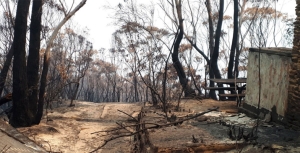Displaying items by tag: fires
Fires and floods
Our Black Summer fires were closely followed by record rainfall and flooding. We were actually up in the Blue Mountains for a week in February 2020 when it virtually poured every day, accumulating more than 500 mm. Soil on steep slopes was either winnowed or swept away along with a mind boggling volume of charred debris. But outcomes from such a scenario can be even worse in a safety sense, as described in an article from The Atlantic Weekly (first published on 1 November in High Country News). I’ve reproduced a couple of paragraphs below.
Two Septembers ago, the residents of Grotto, Washington, woke to the Bolt Creek Fire ripping through the mountains above their homes … No one was hurt, and no houses burned. But now, wildfire survivors in Washington now face a new threat: debris flows. Wildfires can lessen the soil’s ability to absorb water, so when thunderstorms, rapid snowmelt, atmospheric rivers, or rain falling on snow occur in a burned area, that can create a roaring earthen river. Debris flows can move quickly — 30 mph or more — sliding from the uplands to the valley floor in a matter of minutes.
Debris flows are more dangerous than mudslides and slower-moving landslides: They can sweep away boulders, trees, and cars, and threaten everything in their path, including roads and homes and the people who live in them. Last year, in Washington’s Okanogan County, two residents were rescued from their home after earth flowed through a burn scar. Another flow destroyed a cabin and sent a foot of water and mud into at least 30 structures. And in 2018, 23 people were killed when heavy rains triggered a debris flow in the burn scar of Southern California’s Thomas Fire.
John Martyn came across this article in Apple News that’s very relevant for fires in our mountainous districts.

